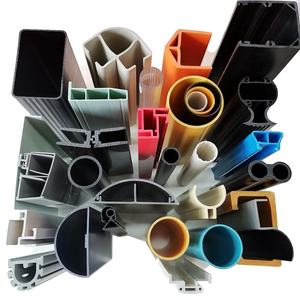Plastic extrusion for reinforced, resilient materials
Plastic extrusion for reinforced, resilient materials
Blog Article
A Comprehensive Guide to the Process and Benefits of Plastic Extrusion
In the huge world of production, plastic extrusion emerges as a very reliable and important procedure. Translating raw plastic right into continuous profiles, it caters to a variety of sectors with its remarkable adaptability.
Recognizing the Essentials of Plastic Extrusion
While it may show up facility at very first look, the procedure of plastic extrusion is essentially easy. The process starts with the feeding of plastic product, in the type of granules, pellets, or powders, right into a heated barrel. The designed plastic is then cooled down, strengthened, and cut right into preferred sizes, completing the process.
The Technical Refine of Plastic Extrusion Explained

Sorts Of Plastic Suitable for Extrusion
The choice of the ideal kind of plastic is a vital element of the extrusion procedure. Numerous plastics supply one-of-a-kind residential or commercial properties, making them much more fit to particular applications. Polyethylene, for instance, is generally used due to its inexpensive and easy formability. It offers outstanding resistance to chemicals and wetness, making it excellent for items like tubes and containers. Polypropylene is an additional popular choice due to its high melting factor and resistance to fatigue. For even more robust applications, polystyrene and PVC (polyvinyl chloride) are typically selected for their strength and toughness. Although these prevail choices, the option ultimately depends on the details needs of the item being created. Understanding these plastic types can dramatically boost the extrusion process.
Contrasting Plastic Extrusion to Other Plastic Forming Methods
Comprehending the kinds of plastic appropriate for extrusion paves the means for a broader conversation on how plastic extrusion stacks up versus various other plastic developing techniques. These consist of shot molding, impact molding, and thermoforming. Each approach has its unique usages and benefits. Shot molding, as an example, is superb for creating complex components, while blow molding is best for hollow things like bottles. Thermoforming excels at developing shallow or big components. However, plastic extrusion is unrivaled when it pertains to creating constant accounts, such as seals, gaskets, and pipelines. It additionally enables a regular cross-section along the length of the item. Therefore, the selection of technique mostly depends on the end-product demands from this source and requirements.
Trick Benefits of Plastic Extrusion in Production
In the realm of manufacturing, plastic extrusion offers numerous significant benefits. One notable benefit is the cost-effectiveness of the procedure, Recommended Site that makes it a financially attractive manufacturing technique. In addition, this strategy supplies remarkable product flexibility and enhanced manufacturing speed, thereby increasing total production effectiveness.
Affordable Production Approach
Plastic extrusion jumps to the leading edge as an economical production approach in manufacturing. This procedure stands out for its capacity to produce high quantities of material swiftly and efficiently, supplying producers with substantial cost savings. The key expense benefit is the ability to make use of less costly basic materials. Extrusion makes use of polycarbonate materials, which are much less costly contrasted to steels or ceramics. Further, the extrusion process itself is fairly simple, minimizing labor prices. Additionally, plastic extrusion needs much less power than traditional manufacturing approaches, adding to lower operational expenses. The procedure additionally minimizes waste, as any excess or faulty materials can be recycled and reused, offering one more layer of cost-effectiveness. Generally, the economic advantages make plastic extrusion a very attractive option in the manufacturing market.

Superior Item Flexibility
Beyond the cost-effectiveness of plastic extrusion, another considerable advantage in manufacturing hinge on its premium item flexibility. This procedure permits the development of a broad array of items with differing shapes, dimensions, and styles, from straightforward Home Page plastic sheets to complex profiles. The adaptability is associated to the extrusion die, which can be tailored to produce the desired item design. This makes plastic extrusion a perfect remedy for markets that require personalized plastic components, such as auto, building, and product packaging. The capability to generate diverse items is not only valuable in meeting details market demands yet also in making it possible for makers to discover new product with minimal capital expense. Essentially, plastic extrusion's product adaptability cultivates development while enhancing functional performance.
Boosted Manufacturing Speed
A substantial advantage of plastic extrusion exists in its improved production rate. Few other production processes can match the speed of plastic extrusion. In addition, the capability to preserve regular high-speed manufacturing without compromising item top quality establishes plastic extrusion apart from other methods.
Real-world Applications and Influences of Plastic Extrusion
In the realm of manufacturing, the technique of plastic extrusion holds profound importance. The economic advantage of plastic extrusion, mostly its high-volume and cost-efficient output, has actually revolutionized manufacturing. The industry is persistently striving for innovations in recyclable and biodegradable materials, indicating a future where the advantages of plastic extrusion can be preserved without endangering environmental sustainability.
Conclusion
Finally, plastic extrusion is a very reliable and reliable approach of transforming resources into varied products. It provides numerous benefits over various other plastic developing methods, consisting of cost-effectiveness, high result, very little waste, and design versatility. Its effect is exceptionally felt in numerous markets such as building, automotive, and durable goods, making it a critical process in today's production landscape.
Digging deeper right into the technical procedure of plastic extrusion, it begins with the selection of the ideal plastic material. Once cooled down, the plastic is cut right into the needed lengths or injury onto reels if the product is a plastic film or sheet - plastic extrusion. Contrasting Plastic Extrusion to Other Plastic Forming Approaches
Recognizing the types of plastic ideal for extrusion paves the means for a wider discussion on just how plastic extrusion stacks up versus various other plastic developing methods. Couple of various other production processes can match the speed of plastic extrusion.
Report this page